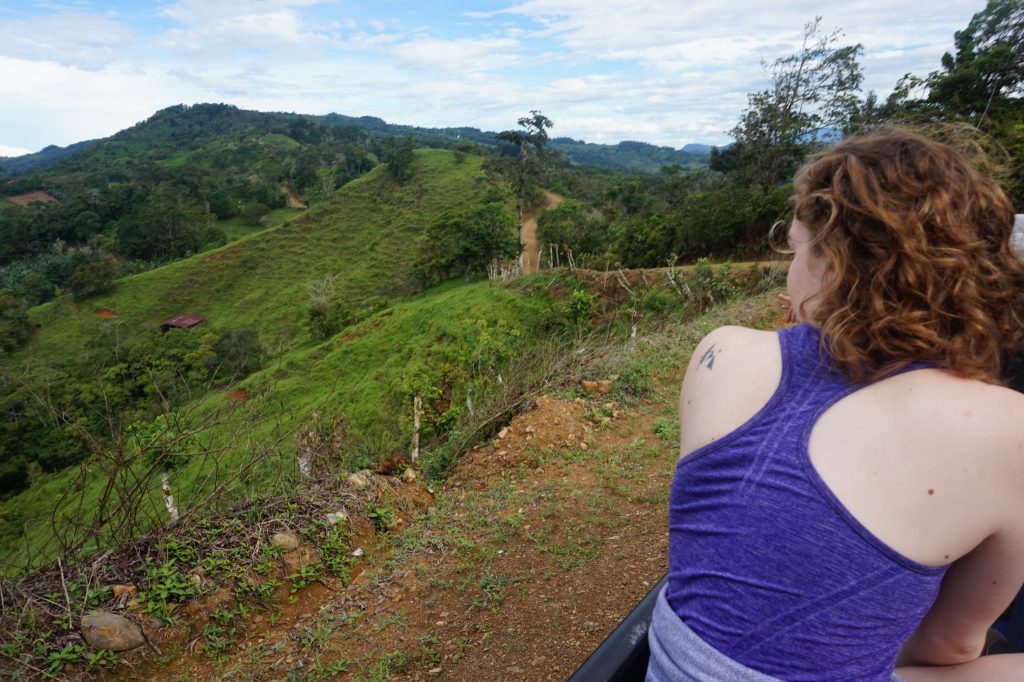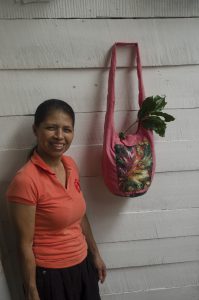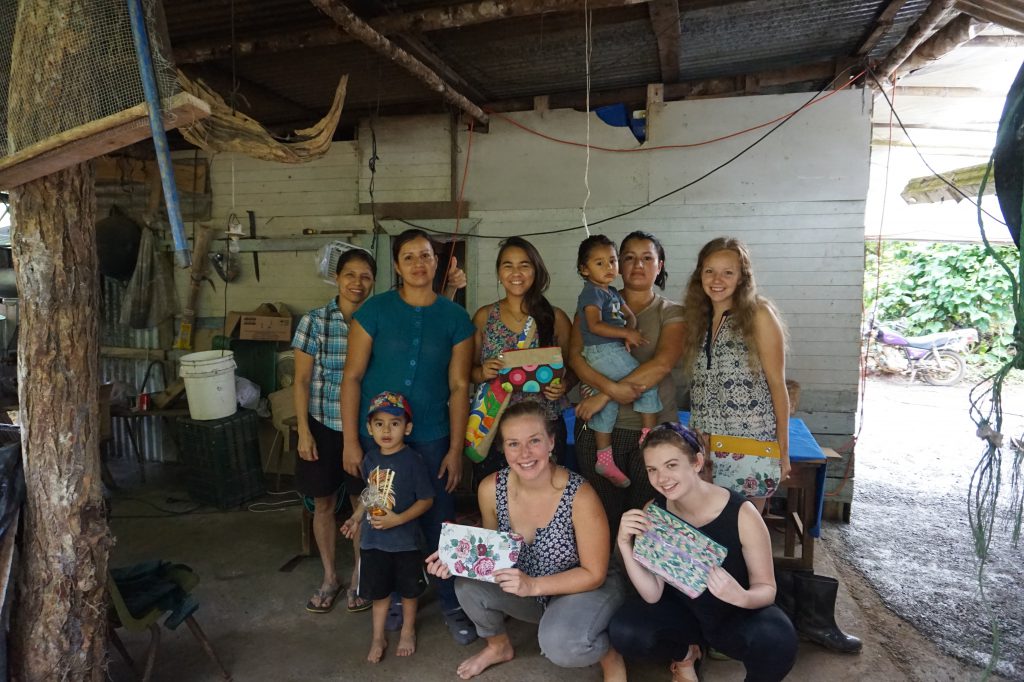
Senior Geography major Anna Ostermeier spent part of last summer in rural Costa Rica working on projects related to environmental sustainability and women’s empowerment. A prestigious Wisconsin Idea Fellowship funded her work, as well as support from Sasha Drumm, Mario Castillo, Nicol Chinchilla, Cathy Middlecamp, Brooke Nelson, Kyle Powers, Morgridge Center for Public Service, and UpTica.
Read our conversation with Anna below to learn more about this inspiring project and how it put her Geography skills to use.
Tell us about how you became a geographer.
I always knew I was interested in the environment, not only in its physical dimension, but also in human interactions with and within it. Before starting undergraduate study, I didn’t quite know how to channel this interest. In my first semester, I took Geography 139 Living in the Global Environment. Themes from the course immediately resonated with me, and I finally had a way to make sense of what I already knew: environmental problems are complex and chaotic; the same problem (and in turn, steps towards a solution) often looks different based on spatial scale and unique social contexts. I had always felt strongly that humans are integrated into their environment, along with all their social, cultural, political, and economic structures. Human-environment geography encourages integrating these many different scopes into how we look at environmental issues. Studying geography became the perfect tool not only in learning about environmental issues, but also in understanding solutions that are socially beneficial and economically viable.

You were awarded a Wisconsin Idea Fellowship. Can you tell us a little bit about what this is, and especially about the project it supported?
The Wisconsin Idea Fellowship (WIF), supported by the Morgridge Center for Public Service, provides financial and advisory support to undergraduate projects that extend benefits of UW-Madison education and research beyond its borders. Inspired by Maria Castillo’s earlier award of the grant, my team, Brooke Nelson, Kyle Powers, Cathy Middlecamp (our faculty mentor), and I applied for the grant. Our project supports an organization called UpTica in combatting unnecessary landfilling of materials, lack of income generating opportunities, and gender inequality in rural communities of Costa Rica. To tackle these issues, UpTica employs craftswomen who create bags out of upcycled and other eco-friendly materials, which promotes sustainable fashion and discourages use of disposable plastic bags. It also has the added benefits of providing skill-building and income-earning opportunities for women, while also developing the local economy. The WIF 2017-2018 funds allow for purchasing of sewing materials and sewing workshops for the women; stipends and field trips for the women; and expansion of promotion and marketing of UpTica’s brand and products. Apart from my involvement with the grant, I also serve as the Communications and Marketing Intern, so I have assisted with social media posts, an informational infographic, and other graphic design projects. I hope to continue my involvement with UpTica post-graduation, as I believe wholeheartedly in their mission.
In what ways did your background in Geography help you prepare for and carry out this work?
- The main barrier in rural Costa Rica, in terms of reduction of waste, is lack of infrastructure which is closely tied to the challenges the physical geography create for transportation. While the mountains of Perez Zeledon are stunning, they are also expensive and time-intensive to traverse. Small communities like San Luis are remote, and rely on recycling and waste disposal facilities in a city called San Isidro, which is more than an hour’s drive away.
- Many of the people we interacted with in the rural communities had a closer relationship with food than most Americans. Because many have small farms and raise animals, they are generally very aware of where their food comes from and are fairly self-sufficient. They have a direct connection to the land because they rely on it to affordably feed themselves and their families. They also often have a great deal of pride in the natural beauty of their country (and the fact that food literally falls off trees), and feel personally responsible for how their own actions impact it. Different culture’s relationships to the environment is a theme that comes up again and again in human-environment geography. Thus, my background helped me better understand and contextualize the cultural valuation of the environment in San Luis and its surrounding communities.
- In geography we also study how institutions and power dynamics shape human interactions with the environment. In Costa Rica, institutions on the local level, like a women’s association or youth group, help communities organize to promote their community’s well-being, which extends to the environment. At a larger institutional scale, in Costa Rica there is also generally a lack of resources channeled towards rural areas. This impacts the environment in several ways, one of which is lack of access to proper disposal of waste due to lack of waste infrastructure. In this sense, it can be very difficult for people in rural communities to act environmentally, as they don’t have easy access to recycling facilities.
- Reaching markets at the different spatial scales of local, domestic, and international is another piece of my involvement with UpTica that has a geographic dimension. Once again, transportation becomes a challenge here.
- As a summer project, I hope to put UpTica’s focus communities on the map, both literally and figuratively. In Geography 572, Graphic Design in Cartography, we discussed the power of what we do and don’t map. If you look for San Luis, Costa Rica, on Google maps, you cannot locate it. My hope is to create a map of San Luis and La Ribera, two of UpTica’s central communities, both to encourage awareness of their presence and where UpTica products come from, but to ensure that the people who live their feel recognized and important. By showing buyers, especially international buyers, where products come from, I can create a connection to those places, and the people who call them home. I believe this is important for not only brand identity, but also community pride and cultural understanding.

What were the most important things you learned through this experience?
Building trust and respect with the community in which a project is centered, and working first and foremost to understand the culture of that community is vital to the project’s sustainability. Furthermore, institutional frameworks often shape both the goals of the project, and the most effective way to implement a project. Local knowledge is an important primary source for information about these institutions, and therefore listening to and understanding representatives of the community are vital. Entering the San Luis community gave us an even deeper understanding that sustainability is already integrated into its culture; the people there take pride in the beauty of Costa Rica and understand the value of its natural resources. Instead of assuming we could teach them about sustainability, we opened our minds to learning from them. We found that most people acted as sustainably as they could, within the restrictions of a limited waste and recycling infrastructure, embedded in the institutional lack of focus on rural economic development. From late-night discussions, we found that many people simply wanted a better future for their children, and understood how treating the environment with respect is central to ensuring that future.
In addition to allowing me to connect with people across cultural and language barriers, UpTica has served as an inspiration to me as a testament to the power young people have to make change. Maria Castillo, a co-founder of the organization, has been a valued friend and colleague for several years now, so I see her as a peer. Maria, along with Nicol Chinchilla and Sasha Drumm, the other co-founders, has started an organization which I feel truly embodies thoughtful and sustainable action. In a time when politics are dominated by climate change denial and our culture seems hopelessly consumed with material wealth, UpTica serves as an example of a small group of young people promoting genuine sustainability without the greenwashing many businesses are guilty of. While the impact may seem small in comparison to so many powerful actors, their organization is gaining support not only from other individuals like myself, but also from institutions like UW-Madison. Furthermore, their efforts create a ripple effect as they inspire others like me to join, and even start their own initiatives.



